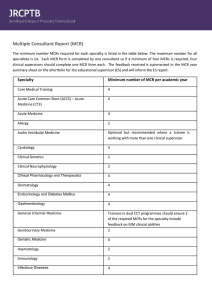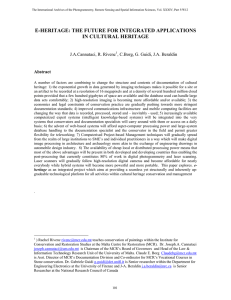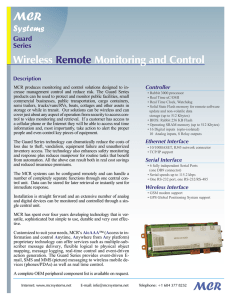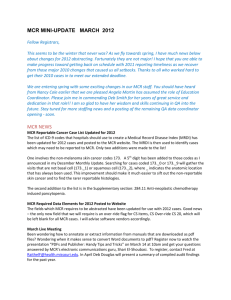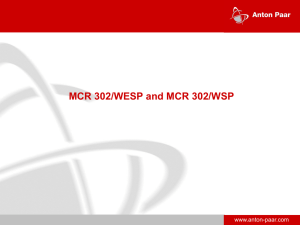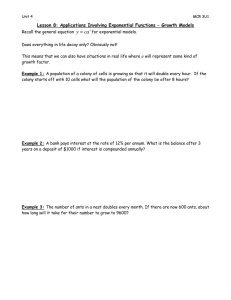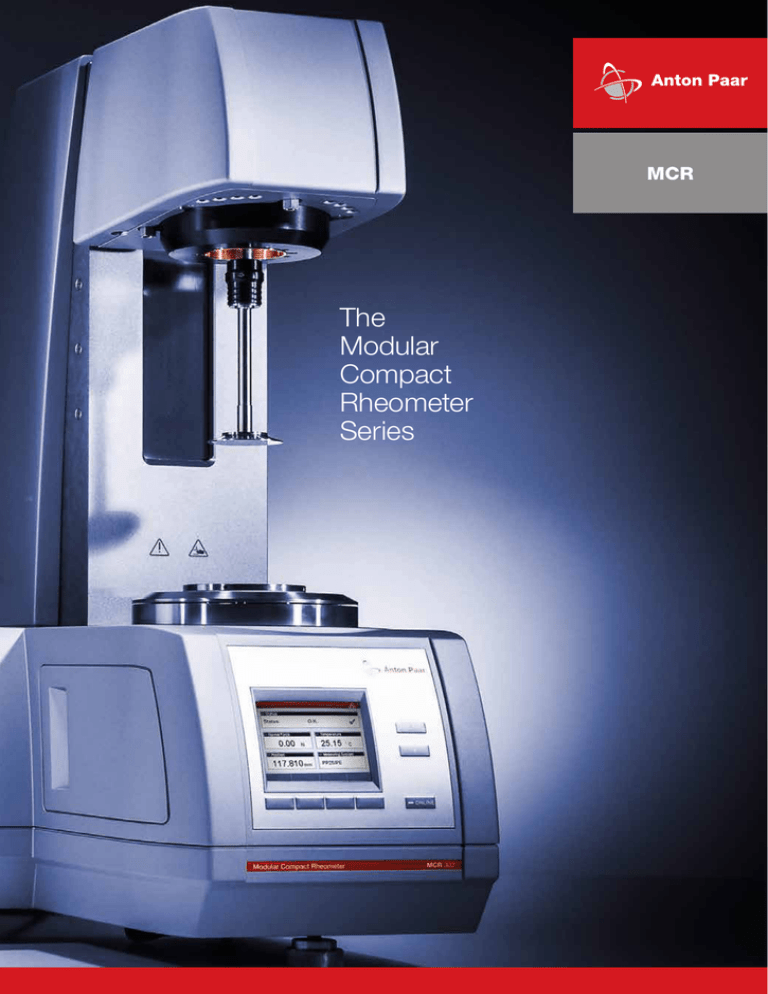
MCR
The
Modular
Compact
Rheometer
Series
r.
e
t
e
m
o
e
h
r
f
o
o
r
p
MCR: Your future
MCR rheometers offer you
one thing first and foremost:
An open range of possibilities.
4-5
What does
modularity mean?
8-9
6-7
How do the synchronous EC
motor’s capacities work for you?
Which features are
available for easy, reliable
MCR operation?
10-11
12-13
Which temperature
control options do you
require?
What are your
advantages due to the
instrument’s design?
14-15
Which accessories are
available to extend the
MCR’s functionality?
18-19
16-17
Which measuring systems
best suit your needs?
Specifications
Look forward to your
future applications…
MCR: The Modular
Compact Rheometer Series
Modular.
MCR rheometry builds on your applications.
Whatever your rheological requirements are and will
be in the future – MCR rheometers are efficiently
and comfortably adapted to meet your needs. The
intuitive application software and patented features
like Toolmaster™, an automatic tool recognition and
configuration system, make sure of this.
RheolabQC
HTR
Changing a cone-plate for a concentric-cylinder measuring
system is just as easy as integrating a new temperature
device or extending your rheometer’s testing capabilities
with a wide range of application-specific accessories.
Compact.
MCR rheometry builds on your working day.
The space-saving MCR rheometers are designed with
a specific focus on ease-of-use, with all components
incorporated into one simply installed unit that easily fits
on a standard laboratory table.
‘Compact’ use of your time is guaranteed: The patented
TruGap™ system for automatic gap control, the T-Ready™
feature for controlling the actual sample temperature, and
of course the speed and precision of the dynamic EC
motor itself – these and other MCR characteristics ensure
efficient rheological operation.
Rheometer.
MCR rheometry builds on technological innovation.
Benefit from rheological highlights such as the air-bearingsupported, synchronous EC motor, the dynamic TruRate™
sample-adaptive motor controller, the patented normal
force sensor integrated in the air bearing, TruStrain™
real-time position control, continuously improved
electronics and numerous other features that ensure
the MCR series’ world-renowned rheological peak
performance.
Anton Paar’s Modular Compact Rheometer series: From
routine quality control applications to high-end research &
development.
4
SmartPave
MCR 102
FRS
ASC
DSR
WESP
WSP
MCR 502 S
MCR 52
MCR 302
MCR 502 TDR
MCR 702
5
New Paths for Your Applications
The RheoCompass™ Software
Your rheometer opens up a constantly growing
number of measurement opportunities. This calls
for a navigation tool that gives you the complete
overview as well as the exact insights you require:
Anton Paar’s new RheoCompass™ software,
the most innovative and up-to-date rheometer
software available on the market.
Designed for intuitive use, RheoCompass™
enables application-oriented template filtering,
customized test and analysis definitions, highly
simplified data retrieval and much more.
6
Patented Features for
Comfort and Efficiency
Automatic recognition
of measuring and environmental systems:
Toolmaster™
The MCR’s modular concept builds on the simple
exchange of measuring systems and environmental
systems. This exchange basically organizes itself in a
very short time – as Toolmaster™ (US Patent 7,275,419)
automatically does the work for you, without any
selections in the software.
Toolmaster™ is the only completely automatic tool
recognition and configuration system for rheology. It
recognizes measuring and environmental systems as soon
as these are connected to the rheometer. Transponder
chips in each accessory’s control cable and in the
measuring system contain all relevant data, such as
truncation, diameter, cone angle and serial number, and
automatically transfer these to the application software.
Error-free documentation and perfect traceability
(21CFR Part 11 compliance) are guaranteed.
Easy fitting of measuring systems:
QuickConnect
QuickConnect additionally offers you mechanical
ease-of-use: The quick-fitting coupling allows one-hand
connection of the measuring systems and ensures fast,
convenient system changes without the use of a screwing
mechanism.
Permanent control of the measuring gap:
TruGap™
Errors in gap size due to thermal expansion or contraction
directly influence the accuracy of results in parallel-plate
and cone-plate measurements.
The patented TruGap™ system (US Patent 6,499,336)
fully replaces these procedures: The gap is directly
measured and precisely adjusted to the desired position
independently of the temperature and thermal expansion.
TruGap™ measuring systems are based on a magnetic
induction principle. An AC current flows through the
primary coil in the lower plate, which induces a voltage
in the secondary coil since the circuit is closed by an iron
disk in the upper measuring plate. Based on this voltage,
the gap size is consistently measured and adjusted.
Time-saving temperature certainty:
T-Ready™
Rheological measurements are strongly influenced
by temperature. Therefore, in addition to accurate
temperature control, knowledge about the sample
temperature equilibration is essential. The new T-Ready™
feature employs TruGap™ functionality to precisely
determine when the desired sample temperature has been
reached. Unnecessarily extended waiting times before
tests are eliminated: T-Ready™ gives a green light so that
the test can be started as soon as the desired sample
temperature is reached.
Intuitive control of your device: MCR color display
With the MCR series’ color display you can manage the
complete sample preparation procedure directly at the
instrument. The softkeys under the screen offer you the
same functionality as a touchscreen, but without the risk
of damaging or contaminating the screen in harsh working
environments. Physical properties such as normal force,
temperature and gap are displayed in a clearly arranged,
accessible fashion.
7
The Key to Accuracy
The EC Motor Technology
The air-bearing-supported synchronous
EC motor (also called DC motor) is the key
component of the MCR rheometer series.
Whether you perform zero-shear viscosity
determinations of low-viscosity polymer
solutions or measure highly viscous
magnetorheological fluids at high shear rates
and strains: The EC (Electrically Commutated)
motor of the MCR series ensures accuracy
across a wide viscosity range – from solids to
liquids with viscosities lower than water.
The rotor of the EC motor drive is equipped with
permanent magnets. In the stator, coils with
opposite polarity produce magnetic poles. The
magnets in the rotor and the stator coils attract
each other, so that a rotating flux of current
in the coil windings produces a frictionless
synchronous movement of the rotor.
The torque of the motor is set and measured
via the input current to the stator coils. Due
to its unique design the EC motor features a
linear relation between the torque and the input
current to the stator coil, which is advantageous
for precise torque control and measurement.
These and other motor characteristics
considerably benefit your rheological
measurements.
8
Motor characteristics
Your rheological advantage
Instantaneous buildup of
magnetic field, no magnetic
induction
Fast response times for
step rate and strain tests
No eddy current and heat
production in motor
Permanent torque values up
to 300 mNm
Linear relationship between
electromagnetic torque and
stator current, one single
motor constant
Control and resolution of
lowest speeds, deflection
angles and torques,
TruStrain™
Known constant magnetic
field allows motor-controlled
blocking
“Trimlock”: Motor-controlled
blocking during sample
trimming
The optical encoder
The high-resolution optical encoder based on data
oversampling technology enables the measurement
and control of angular deflections down to 50 nanorad.
Combined with TruStrain™ this provides the basis for
comprehensive studies of samples with weak structures.
The speed of completely digital control
The use of the most recent processor technology in the
MCR series increases the speed of data processing and
increases the efficiency of transient tests. Due to the
additional memory, important signals such as the torque
and deflection angle are recorded and processed with
higher signal density.
Anton Paar builds on a long-standing working experience
with Digital Signal Processing (DSP) – with the MCR series
being the first rheometers ever based on this technology.
As a result of constant optimization, MCR rheometers are
now also controlled with digital current sources. The low
fluctuation and high performance of these sources further
increases the accuracy of MCR torque measurement and
control.
The air bearing
Two air bearings support the motor: A radial air bearing
centers and stabilizes the shaft and the axial air bearing
holds the weight of the rotating parts.
This established air bearing technology is independent of
external influences and therefore applicable without further
electronic control.
Continuously optimized for rigidity, drift stability and
robustness, the MCR rheometers’ air bearing technology
together with improved torque scanning enables low-torque
measurements down to a minimum of 0.5 nNm.
The patented normal force sensor
The high sensitivity and increased sampling rate of the
patented normal force sensor (US Patent 6,167,752)
integrated in the air bearing enables normal force
measurements during transient and steady-state tests as
well as static normal force measurements, which are used
for gap control and DMTA, tack or penetration tests.
The sensor employs an electric capacity method, precisely
converting extremely small deflections in the air bearing into
the according normal force. Instead of enforcing additional
travel, the natural movement already present in the air
bearing is used to measure the normal force.
The advantage of the sensor’s location in the air bearing:
Normal force measurements are available for all
temperature devices and application-specific accessories.
Whatever your application, the normal force sensor is
always immediately functional.
9
Intelligent
Design
Space to work: The housing
Ergonomics, functionality and durability were the central
design goals of the compact MCR housing. All mechanical
and electrical control components are incorporated
into one single, simply installed unit that easily fits on a
standard laboratory table. You are given sufficient space
for sample loading, trimming and further preparation.
The mechanical self-alignment of all accessories ensures
comfortable work with the modular MCR system. In
addition, customized housing solutions are available, e.g.
for adaptation to a confocal microscope.
Maximum rigidity: The frame
Due to the MCR rheometers’ rigidity, changes in
environmental temperature cannot influence the results of
long-term tests. The new MCR series are built with a steel
frame for optimized mechanical and thermal stability. In
addition to the low elastic compliance of the steel itself,
the Isolign™ Piezo Flange actively compensates the
residual compliance.
Compliance in check: The IsoLign™ Piezo Flange
The unique IsoLign™ Piezo Flange enables nanometerscale gap size changes (10 nm) by three Piezo elements
in the rheometer’s bottom flange. This system provides
additional measuring gap constancy – an especially vital
feature for long-term measurements at low torques – and
actively compensates the entire system’s axial compliance
in transient tests.
Connections
The modular concept of the MCR series is well reflected
by the instrument’s interfaces. The result: More options for
flexible work.
4USB interface for direct communication with computer
4Ethernet interface for direct or network communication
44 analog interfaces for triggering external devices
42 auxiliary inputs for reading external devices
4Thermocouple interface for temperature reading
4Pt 100 interface for temperature reading
10
Intelligent
Control
TruRate™
The MCR series’ TruRate™ sample-adaptive controller
intelligently adapts to the sample conditions at hand.
Without prior information on the sample, and without any
pre-testing, sample strains, shear rates or stresses are
precisely controlled. The desired settings are achieved
in minimum time; no additional software selections are
required.
TruRate™ swiftly adjusts to the desired shear rate step
or step in strain without overshoots – for accurate
investigations of all kinds of samples.
TruStrain™
Strain-controlled oscillatory tests with common stresscontrolled (CS) rheometers usually require a “guessing
game”, including several oscillation cycles and subsequent
adjustments, to reach the desired strain amplitude.
TruStrain™ takes a different approach: Instead of amplitude
control, it employs real-time position control based on the
Direct Strain Oscillation (DSO) method. This ensures more
efficiency and drift-free measurements at smallest torques
and strains.
TruStrain™ adjusts to the desired strain directly on the
sine wave, and the measuring system directly follows
this required change in strain during each individual
oscillation cycle. This means you are able to preset and
control precisely sine-shaped strains both within the
linear viscoelastic (destruction-free) range as well as in
Large Amplitude Oscillatory Shear (LAOS) conditions. For
close observation of intercycle processes, the application
software optionally displays oscillatory waveforms and
Lissajous diagrams.
TruStrain™ is especially valuable for oscillatory
measurements on complex fluids such as gels, emulsions,
suspensions, colloids, surfactant solutions, lubricating
grease and foams.
All rheological parameters
The electric motor torque, the forcing frequency (set
values) and the total moment of inertia or, alternatively, the
deflection angle and the phase shift between the electric
motor torque and the angle response (measured values),
can be used to determine all rheological parameters.
11
Modular Temperature Control…
Anton Paar offers a wide range of modular temperature
devices tailored to specific rheological requirements
– from -150 °C to 1000 °C, from low-viscosity liquids
to highly elastic solids, from traditional rheological
tests to DMTA measurements. All systems are easily
exchanged within the MCR series and ensure virtually
gradient-free temperature control for all applications.
Make your first selection here.
C-PTD 200
C-PTD 180/AIR
-30 °C to 200 °C
0 °C to 180 °C
4Cylinder
4Conduction
4Patented
(US Patent 6,240,770)
C-ETD 200/300
RT* to 200/300 °C
4Cylinder
4Conduction
P-PTD 200
P-PTD 200/AIR
-40 °C to 200 °C
-5 °C to 200 °C
4CP/PP
4Conduction
4Convection
4Radiation
4Patented (US Patent 6,571,610)
Low-viscosity liquids
Viscoelastic liquids
Melts
Paste-like materials
Gel-like materials
Soft solids
Powder/reactive systems
4Fully incorporated, truly Peltiertemperature-controlled system
4High heating and cooling rates
4No vertical temperature gradient
in sample due to patented thermal
transfer system
4Counter-cooling by air or fluid
circulator
4Temperature control for pressure
cells (C-PTD 200)
12
4Especially suited for
measurements of lowviscosity samples at high
temperatures
4High heating rates
4Ideal for use with pressure
cell
* Room temperature
4Fully incorporated, truly Peltiertemperature- controlled system
4TruGap™ support
4T-Ready™ feature
4Sliding rail for easy access and
sample trimming
4Evaporation Blocker: prevents loss of
volatile solvents
4Temperature-isolated hood (handwarm for safe use)
4Isolated hood according to
EN61010-1:2001
…from –150 °C to 1000 °C
Anton Paar’s temperature devices are based on the
physical principles of conduction, convection and
radiation.
CTD 180
ETD 400
CTD 450 TDR
CTD 1000
-20 °C to 180 °C
-150 °C to 400 °C
-150 °C to 450 °C
-150 °C to 1000 °C
4CP/PP/CC/DMTA solid and
extensional fixtures
4Convection
4Radiation
4CP/PP
4Conduction
4Convection
4Radiation
4CP/PP/CC/DMTA solid and
extensional fixtures
4Convection
4Radiation
4CC/PP
4Cylinder
4Convection
4Radiation
Solids
Solids
4Truly Peltier-temperaturecontrolled convection oven
4TruGap™ support
4T-Ready™ feature
4DigitalEye CCD camera function
4Modular configuration (DMTA
torsion/tension, Photo DMTA/
UV, reaction kinetics, SER
extensional rheology)
4Humidity Option
4Temperature-isolated jacket
(hand-warm for safe use)
4Ideal for measurements of
tablets, granules and powders
4Sliding rail for easy access and
sample trimming
4Temperature-isolated hood
according to EN 61010-1:2001
(hand-warm for safe use)
4High heating rates
4Cooling by gas, water or liquid
nitrogen
4Modular configuration (DMTA torsion/
tension, Photo DMTA/UV, reaction
kinetics, SER extensional viscosity)
4TruGap™ support
4T-Ready™ feature
4Digital Eye CCD camera function
4Pt 100 signal reflects true sample
temperature
4Temperature-isolated jacket (handwarm for safe use)
4Actively cooled jacket according to
EN 61010-1:2001
4Evaporation unit actively controls
continuous flow of liquid nitrogen:
most stable temperature signal for
low-temperature applications
4Gas-Chiller Option for cooling without
liquid nitrogen
4Most suitable for
measurements of glass and
metal melts
4Thermocouple signal reflects
true sample temperature
4Temperature-isolated jacket
(hand-warm for safe use)
4Actively cooled jacket
according to EN 61010-1:2001
4Evaporation unit actively
controls continuous flow of
liquid nitrogen: most stable
temperature signal for lowtemperature applications
13
Build on Your Rheometer:
Application-specific Accessories
Structure Analysis
Gather sample structure information
by combining these optical and
dielectric methods with rheology.
Rheo-Microscopy
(Fluorescence,
Polarized,
Non-Polarized)
Small-angle light
scattering (SALS)
Dynamic Optical
Rheo-Analyzer
(Birefringence,
Dichroism)
Small-angle
X-ray
scattering
(SAXS)
Pressure cells
UV Curing System
Immobilization Cell
MagnetoRheological
Device
Extensional
rheology
Dynamic
mechanical
thermal analysis
(DMTA)
Starch rheology
Large-particle
rheology
Additional
Parameter Setting
Employ these accessories to set
additional parameters together with
the temperature for rheological
tests.
Extended Material
Characterization
These accessories transfer the
MCR rheometer’s measuring
capabilities into other material
characterization applications.
14
Obtain additional structure information, set additional parameters or employ the rheometer’s
functionality for further material characterization: This wide range of application-specific
accessories is easily integrated into your MCR rheometer.
MCR
Application-specific
Accessories for
Structure Analysis
Small-angle neutron
scattering (SANS)
Particle image
velocimetry (PIV)
Polarized Imaging
DielectroRheological
Device (DRD)
MCR
Applicationspecific
Accessories
for Additional
Parameter
Setting
ElectroRheological
Device
Humidity Option
for CTD 180
MCR
Extended Material
Characterization
Interfacial
rheology
Tribology:
Ball on three plates
Pin on disk
Four ball
Powder Cell
15
The Advantage of Diversity
MCR Measuring Systems
The MCR measuring systems can be used with all
temperature devices and are interchangeable within
their category of accessories. For example, a PP25
parallel-plate measuring system can be used in all
according LTD, PTD, ETD or CTD systems.
Lowviscosity
liquids
16
Concentric
Cylinder (CC)
Viscoelastic
liquids
Double Gap
(DG)
Melts
Cone-Plate
(CP)
Paste-like
materials
Parallel Plate
(PP)
All geometry dimensions, safety limitations and
calibration constants are saved in the Toolmaster™
chip located in the coupling of every measuring system.
Made from diverse materials and featuring different
surfaces and dimensions, all measuring systems are
optimized regarding compliance, thermal expansion
and thermal conductivity.
Gel-like
materials
Tack
Systems
Soft solids
Tribology
Systems
Stirrers
Powder/
reactive
systems
DMTA
Torsion
Solids
DMTA
Extension
Measuring System Variants
With hundreds and hundreds of measuring systems,
and their efficient combination with a wide range of
environmental systems, there is barely any application
that cannot be covered by an Anton Paar MCR
rheometer.
Prefix
D :::
DC :::
FDD :::
DD :::
CAP :::
D
Shaft
PR :::
Z :::
PE :::
ERD :::
MRD :::
TG :::
DI :::
CTD :::
Disposable plate
Disposable cup
Fixture for disp. dishes
Disposable dish
Cap plate
–
P
P
–
20
The following nomenclature gives you an overview of
available measuring system variants and how they are
denoted.
Pressure
Zerodur shaft
PEEK shaft
Electro-Rheological Device
Magneto-Rheological Device
TruGap™
Dielectro-Rheological Device
Convection Temperature Device
–
P
R
/
Material
SS ::: Stainless steel
TI ::: Titanium
HA ::: Hastelloy
INV ::: Invar
PC ::: Polycarbonate
AL ::: Aluminum
GL ::: Glass
INC ::: Inconel
CA ::: Carbon
S
S
/
S
Dimension in mm
Type
CC :::
DG :::
ST :::
PP :::
CP :::
ME :::
BM :::
PPR :::
CPR :::
Concentric cylinder
Double gap
Stirrer
Parallel plate
Cone-plate
Mooney Ewart
Ball measuring system
Plate-plate ring
Cone-plate ring
SRF :::
SCF :::
UXF :::
SER :::
BIC :::
BC :::
TG :::
MD :::
Solid rectangular fixture
Solid circular fixture
Universal extensional fixture
Sentmanat ext. rheometer
Bi-cone
Tribology system
Twin gap
Measuring dish
Surface
S :::Sandblasted
P2 ::: Profile 2 (PP), 0.5 mm
P3 ::: Profile 3 (PP), 0.1 mm
P6 ::: Profile 6 (bob, beaker), 1.5 x 0.5 mm
P7 ::: Profile 7 (bob, beaker), 2.3 x 0.5 mm
PX ::: Profile special
HL ::: Helical profile left handed
HR ::: Helical profile right handed
HX ::: Helical profile special
CX::: Coated
17
Pushing the Boundaries of Rheometry:
MCR Rheometers Achieve Lowest Ever Torque
MCR rheometers are constantly being improved by a dedicated development team
continuously furthering the rheometers’ core components. Anton Paar now reports a
significant breakthrough in the minimum torque levels that can be measured – see data below.
The technology developed for the groundbreaking T system has been applied to
the controller at the core of every MCR motor, and new production processes have been
introduced. This means that the entire MCR series can now provide results of even greater
precision, which is reflected in a new set of specifications.
Enhanced low-torque performance in
shear-rate-controlled tests
A shear-rate-controlled rotational test in the figure below
shows the certified viscosity of a standard oil within 5 %
down to a torque of 1 nNm. This screenshot is taken directly
from the software; every single point is displayed, showing
the equidistance of point distribution in a precise shear-ratecontrolled test without any extrapolation.
TruStrainTM control with increased data accuracy
The figure below shows a strain sweep in strain control down
to a torque of 0.45 nNm. This snapshot from the software is
also an actual measurement without any further processing or
hidden data points. Therefore the data points are equidistantly
distributed.
Measurements tell you more than words
The new specifications of Anton Paar’s rheometers are shown
by a single measurement. Come to one of Anton Paar’s various
demonstration labs worldwide – let experts measure your sample
and discuss your specific application. Anton Paar is ready to help
you fulfill your application requirements.
18
Specifications
Unit
MCR 52
MCR 102
MCR 302
MCR 502 TDR
Bearing
-
Ball
Air
Air
Air
EC motor (brushless DC) with high-resolution optical encoder
-
Permanent torque (60 min), no signal drift
-
EC mode (controlled shear rate and shear stress)
230 (300)
(4
Maximum torque
mNm
200
200
200
Minimum torque, rotation
nNm
200 µNm
5
1
1
Minimum torque, oscillation
nNm
200 µNm
7.5
0.5
0.5
Angular deflection, set value
µrad
1 to ∞
0.5 to ∞
0.05 to ∞
0.05 to ∞
Step rate, time constant
ms
-
5
5
5
Step strain, time constant
ms
-
10
10
10
Step time (rate, strain), 99 % of set value (all samples)
ms
-
30
30
30
(1
rad/s
10-4
10-8
10-9
10-9
rad/s
314
314
314
314
rad/s
10-3
10-7 (3
10-7 (3
rad/s
628
628
628
628
N
-
0.01 to 50
0.005 to 50
0.005 to 50 (70) (4
mm
678 x 444 x 586
678 x 444 x 586
678 x 444 x 586
753 x 444 x 586
kg
42
42
42
47
Minimum angular velocity
Maximum angular velocity
Minimum angular frequency
(2
Maximum angular frequency
Normal force range
Dimensions
Weight
Toolmaster™, measuring system; Toolmaster™, measuring
cell; QuickConnect for measuring systems, screwless;
electronic trimlock for the measuring system
-
Digital Eye, Software video option and camera
-
Virtually gradient-free (horizontal, vertical) temperature control
-
10-7
(3
CoolPeltier™, Peltier system with built-in cooling option
requiring no additional accessories for counter-cooling
°C
-5 to 200
-5 to 200
-5 to 200
-5 to 200
Peltier-based convection oven, does not require LN2 for cooling
-20 to 180
-20 to 180
-20 to 180
°C
-20 to 180
Actively Peltier-controlled hood, Peltier technology
°C
-40 to 200
-40 to 200
-40 to 200
-40 to 200
Concentric-cylinder Peltier temperature control
°C
-30 to 200
-30 to 200
-30 to 200
-30 to 200
Maximum temperature range
°C
-150 to 1000
-150 to 1000
-150 to 1000
-150 to 1000
Pressure range
bar
up to 1000
up to 1000
up to 1000
up to 1000
Automatic gap control/setting, AGC/AGS
-
TruGap™ for in-place measurement and control of the gap
-
T-ready
-
Direct strain/stress amplitude controller
-
TruRate™
-
TruStrain™
-
Normal force and velocity profiles, tack, squeeze
-
Raw data (LAOS, waveform, ...)
-
IsoLign™ Piezo Flange
-
With Exposed Support Plate (WESP), Without any Support
Plate (WSP)
-
Connections
1)
2)
3)
4)
Depending on measuring point duration and sampling time, practically any value is achieved
Set frequencies below 10 -4 rad/s are of no practical relevance due to the measuring point duration > 1 day
Theoretical value (duration per cycle = 2 years)
MCR 502 S
USB, Ethernet, 4 analog interfaces, 3 auxiliary inputs,
Pt 100 and thermocouple interfaces
Legend:
optional
19
© 2016 Anton Paar GmbH | All rights reserved.
Specifications subject to change without notice.
C92IP001EN-I

